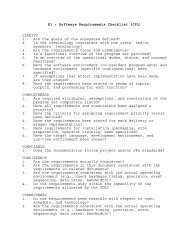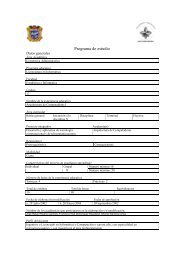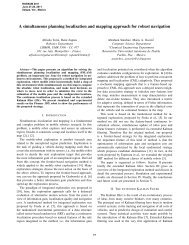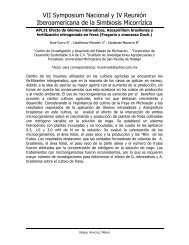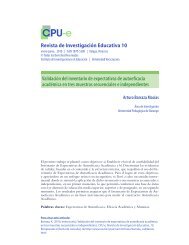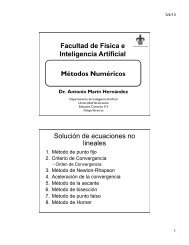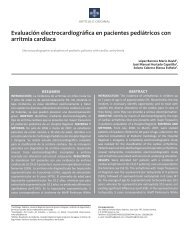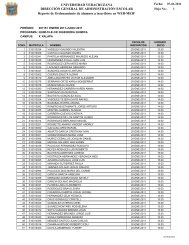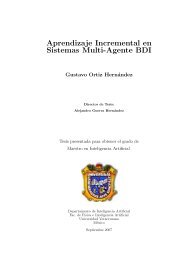Suplemento 2 Vol 8 No 1.indd - Universidad Veracruzana
Suplemento 2 Vol 8 No 1.indd - Universidad Veracruzana
Suplemento 2 Vol 8 No 1.indd - Universidad Veracruzana
Create successful ePaper yourself
Turn your PDF publications into a flip-book with our unique Google optimized e-Paper software.
sometidos día con día.<br />
Ahora sabemos que existe una buena razón para<br />
dormir; la cantidad de sueño necesaria día a día depende de<br />
cada persona y de sus hábitos. Una tercera parte de nuestra<br />
vida dormimos y si no lo hacemos, tenemos como resultado<br />
la muerte. El dormir nos ayuda a mantenernos alerta ante<br />
todos los estímulos sensoriales, hace que seamos más<br />
receptivos a toda la información recibida, mucha de la cual<br />
será almacenada cuando vayamos a dormir.<br />
Agradecimientos<br />
Los autores de este capítulo agradecen al M. en N. Arturo<br />
Venebra por la edición de las imágenes y al apoyo recibido<br />
por el CONACYT 212045 y PROMEP proyecto UVER-PTC-118.<br />
BIBLIOGRAFIA<br />
1. Austin MC, Rhodes JL, Lewis DA. Differential<br />
distribution of corticotropin-releasing hormone<br />
immunoreactive axons in monoaminergic nuclei of<br />
the human brainstem. Neuropsychopharmacology.<br />
1997 <strong>No</strong>v;17(5):326-41.<br />
2. Bonnet C, Léger L, Baubet V, Debilly G, Cespuglio<br />
R. Influence of a 1 h immobilization stress on<br />
sleep states and corticotropin-like intermediate<br />
lobe peptide (CLIP or ACTH18-39, Ph-ACTH18-<br />
39) brain contents in the rat. Brain Res. 1997 Mar<br />
14;751(1):54-63.<br />
3. Drucker-Colín R. The function of sleep is to<br />
regulate brain excitability in order to satisfy the<br />
requirements imposed by waking. Behav Brain<br />
Res. 1995; 69: 1117-1124.<br />
Revista Médica<br />
4. el Kafi B, Cespuglio R, Leger L, Marinesco S,<br />
Jouvet M. Is the nucleus raphe dorsalis a target for<br />
the peptides possessing hypnogenic properties?<br />
Brain Res. 1994 Feb 21;637(1-2):211-21.<br />
5. García-García F, Beltran-Parrazal L, Jimenez<br />
Anguiano A, Vega Gonzalez A, Drucker-Colín<br />
R. Manipulations during forced wakefulness have<br />
differential impact on sleep architecture, EEG<br />
power spectrum, and Fos induction. Brain Res.<br />
Bull. 1998; 47: 317-324.<br />
6. García-García F, Drucker-Colín R. Endogenous<br />
and exogenous factors on sleep-wake regulation.<br />
Prog Neurobiol. 1999; 56(4): 297-314.<br />
7. García-García F. La vigilia como regulador del<br />
sueño: estudio sobre los péptidos involucrados.<br />
Tesis Doctoral. UNAM. 2000, pp 137.<br />
8. García-García F, Drucker-Colín R. Nutritional<br />
impact on sleep-wake cycle. En Fernstrom, J.D.,<br />
Uauy, R. y Arroyo, P. ed.: Nutrition and Brain.<br />
Karger AG, Basel, <strong>Vol</strong>. 5, 2001: 189-199.<br />
9. Radulovic J, Sydow S, Spiess J. Characterization of<br />
native corticotropin-releasing factor receptor type<br />
1 (CRFR1) in the rat and mouse central nervous<br />
system. J Neurosci Res. 1998 <strong>No</strong>v 15;54(4):507-<br />
21.<br />
10. Rampin C, Cespuglio R, Chastrette N, Jouvet<br />
M. Immobilisation stress induces a paradoxical<br />
sleep rebound in rat. Neurosci Lett. 1991 May<br />
27;126(2):113-8.<br />
Autor Responsable:<br />
Dr. Fabio García García<br />
Departamento de Biomedicina, Instituto de Ciencias de la Salud,<br />
<strong>Universidad</strong> <strong>Veracruzana</strong>. Av. Luis Castelazo Ayala s/n. Col. Industrial-Animas.<br />
Xalapa Ver., México. C.P. 91190.<br />
Teléfono: (228) 8418925<br />
Email: fgarcia@uv.mx<br />
Revista Médica de la <strong>Universidad</strong> <strong>Veracruzana</strong> / <strong>Suplemento</strong> 2 <strong>Vol</strong>. 8 núm. 1, Enero - Junio 2008 67



